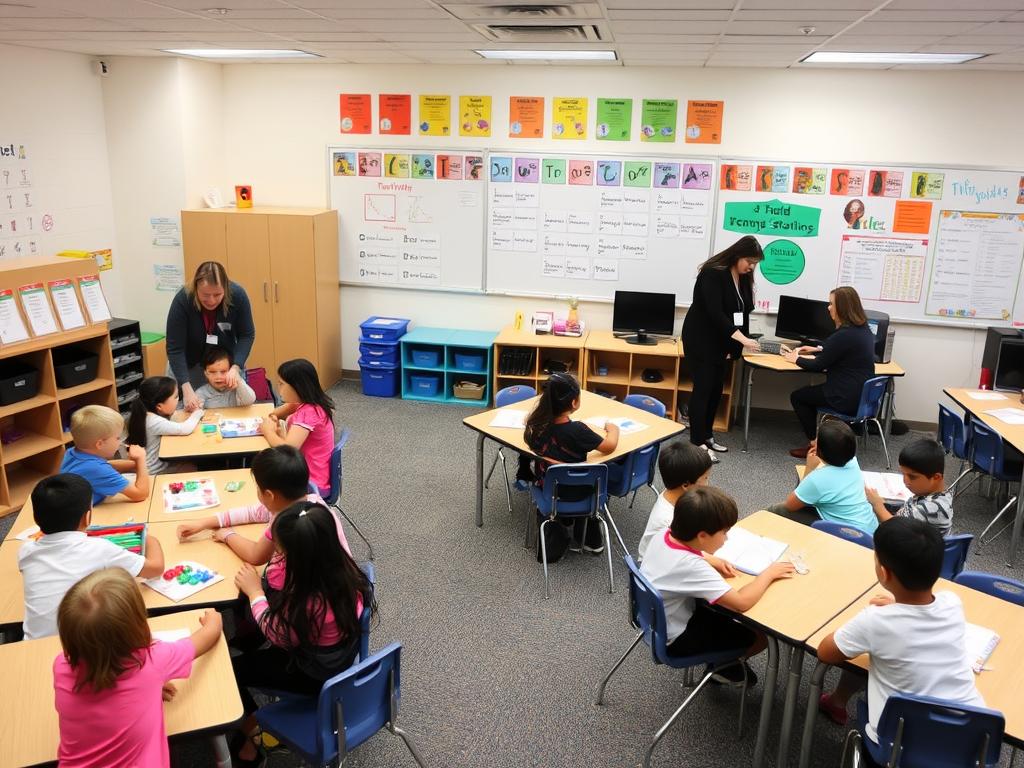What is Co-Teaching?
Co-teaching is a collaborative teaching approach where two educators share responsibility for planning, instructing, and evaluating a group of students. While the most common arrangement pairs a general education teacher with a special education teacher, co-teaching can also involve two general education teachers, specialists, or instructional coaches working together.
This instructional method creates more inclusive classrooms where students with diverse learning needs can thrive together. By combining their unique teacher skills and perspectives, co-teachers can provide differentiated instruction, more individualized attention, and create a richer learning environment than either could accomplish alone.
Effective co-teaching requires mutual respect, clear communication, shared planning time, and a willingness to be flexible. When implemented properly, co-teaching benefits both students and teachers by fostering collaboration, reducing teacher isolation, and improving instructional quality.
Enhance Your Co-Teaching Skills
Looking to develop effective co-teaching strategies? Our specialized professional development courses can help you master essential teacher skills for collaborative classrooms.
Benefits of Co-Teaching Models
For Students
- Reduced student-teacher ratio for more individualized attention
- Access to diverse teaching styles and expertise
- More opportunities for differentiated instruction
- Inclusive environment for students with diverse learning needs
- Improved classroom management and student engagement
- Enhanced social skills through collaborative learning models
For Teachers
- Shared responsibility for planning, instruction, and assessment
- Opportunities to learn new teacher skills from colleagues
- Reduced professional isolation and increased support
- More creative and innovative lesson planning
- Balanced workload when responsibilities are shared effectively
- Professional growth through collaborative reflection
Research consistently shows that well-implemented co-teaching leads to improved academic outcomes, particularly for students with learning differences. A study published in the Journal of Special Education found that students in co-taught classrooms demonstrated greater academic growth compared to those in traditional single-teacher settings.
Co-Teaching Models: Team Teaching
Team teaching, sometimes called “tag team teaching,” is perhaps the most collaborative of all Co-Teaching Models. In this approach, both teachers share equal responsibility for planning and delivering instruction to the entire class simultaneously.
“Team teaching requires the highest level of trust and compatibility between co-teachers, but often yields the most seamless integration of teaching styles and expertise.”
What It Looks Like
In team teaching, both educators are actively involved throughout the lesson. They may take turns leading different parts of instruction, jump in to elaborate on each other’s points, or divide content based on their areas of expertise. This dynamic approach models collaborative problem-solving and shows students how professionals can work together effectively.
Example in Action
During a science lesson on ecosystems, Ms. Johnson (general education teacher) might introduce the concept while Mr. Rivera (special education teacher) prepares visual aids. As Ms. Johnson explains food chains, Mr. Rivera jumps in to provide real-world examples. They seamlessly transition between roles, with both teachers circulating to check for understanding and provide support.
Benefits
- Provides students with multiple perspectives and teaching styles
- Creates a dynamic, engaging classroom environment
- Allows teachers to showcase complementary teacher skills
- Models effective collaboration for students
- Enables flexible grouping and differentiation
Challenges
- Requires extensive planning and coordination
- Demands strong interpersonal compatibility
- May confuse students if transitions aren’t smooth
- Needs clear communication about roles and responsibilities
- Takes time to develop an effective rhythm
When to Use Team Teaching
Team teaching works best when:
- Both teachers have strong content knowledge
- The lesson benefits from multiple perspectives
- Teachers have established a strong working relationship
- Complex concepts require varied instructional approaches
- Modeling collaboration is a learning objective
Co-Teaching Models: One Teach, One Observe
The “One Teach, One Observe” model is a straightforward approach where one teacher leads instruction while the other systematically observes the class. This model is particularly valuable for gathering data on student behavior, engagement, and learning patterns.
What It Looks Like
In this arrangement, the lead teacher delivers the lesson to the entire class while the observing teacher collects specific data. The observer might track student participation, note confusion points, document behavior patterns, or assess the effectiveness of instructional strategies.

Example in Action
During a math lesson on fractions, Mr. Garcia teaches the whole class while Ms. Williams observes from the back, noting which students struggle with equivalent fractions. She documents specific misconceptions and engagement levels, gathering data that will inform future lesson planning and potential interventions.
Benefits
- Provides valuable data for instructional decision-making
- Allows for targeted observation of specific students
- Helps identify patterns that might otherwise go unnoticed
- Supports evidence-based interventions
- Requires minimal joint planning
Challenges
- May create perception of unequal teacher roles
- Doesn’t maximize both teachers’ instructional capacity
- Can feel uncomfortable for the observed teacher
- Limits immediate intervention opportunities
- Requires training in effective observation techniques
When to Use One Teach, One Observe
This model is most effective when:
- Specific data is needed for IEP meetings or RTI processes
- Teachers want to assess the effectiveness of new strategies
- Identifying patterns in student behavior or engagement
- Documenting progress of particular students
- Building evidence for instructional adjustments
To maximize the effectiveness of this model, teachers should alternate roles regularly and use structured observation protocols to ensure data collection is purposeful and actionable.
Develop Your Teacher Skills
Want to improve your observation and data collection techniques? Our professional development resources can help you enhance these critical teacher skills.
Co-Teaching Models: One Teach, One Assist
In the “One Teach, One Assist” model (sometimes called “One Teach, One Drift”), one teacher leads instruction while the other circulates throughout the classroom, providing support to individual students or small groups as needed.
What It Looks Like
The lead teacher delivers the primary instruction to the whole class, while the assisting teacher moves around the room, monitoring student understanding, providing additional explanations, redirecting off-task behavior, and offering individualized support. This approach allows for immediate intervention without disrupting the flow of the lesson.

Example in Action
During a writing workshop, Ms. Chen leads a mini-lesson on descriptive language at the front of the room, while Mr. Thomas circulates among students, checking their progress, clarifying instructions, and providing targeted support to those who need help generating ideas or organizing their thoughts.
Benefits
- Provides immediate support to struggling students
- Allows for real-time differentiation
- Minimizes behavior issues through proximity
- Enables continuous assessment of understanding
- Requires less joint planning than other models
Challenges
- Can create perception of unequal teacher status
- May lead to overreliance on one teacher for instruction
- Limits the assisting teacher’s instructional role
- Can create dependency if students always receive immediate help
- Might reinforce the view of one teacher as the behavior manager
When to Use One Teach, One Assist
This model works particularly well when:
- One teacher has specialized content expertise
- Students need varying levels of support
- The lesson involves complex procedures or directions
- Immediate feedback is important for learning
- Classroom management requires additional support
To prevent this model from creating an imbalanced teaching partnership, co-teachers should regularly switch roles and clearly communicate the value of both positions to students.
Co-Teaching Models: Station Teaching
Station teaching divides students into groups that rotate through different learning stations, with teachers stationed at specific areas to provide instruction on different aspects of the curriculum. This model maximizes small group interaction and allows for targeted teaching.
What It Looks Like
The classroom is organized into three or more learning stations. Each teacher leads instruction at one station, while additional stations might involve independent work, peer collaboration, or technology-based activities. Students rotate through all stations during the lesson, experiencing varied approaches to the content.

Example in Action
In a language arts class studying poetry, Ms. Adams leads a station on analyzing poetic devices, while Mr. Patel facilitates a creative writing station where students compose their own poems. A third station involves independent reading of selected poems, and a fourth incorporates digital tools for recording spoken word poetry. Students spend 15-20 minutes at each station before rotating.
Benefits
- Reduces student-teacher ratio during instruction
- Allows teachers to use their specialized teacher skills
- Provides varied approaches to learning the same content
- Increases student engagement through movement and variety
- Creates opportunities for targeted small group instruction
Challenges
- Requires significant planning and preparation
- Needs clear procedures for transitions between stations
- May create noise and management challenges
- Demands careful timing to ensure all students access all content
- Requires independent work skills for unattended stations
When to Use Station Teaching
Station teaching is particularly effective when:
- Content can be divided into discrete segments
- Students benefit from varied instructional approaches
- Reducing the student-teacher ratio would enhance learning
- The lesson incorporates multiple skills or concepts
- Teachers have different areas of expertise to share
Master Station Teaching Strategies
Looking for practical ways to implement station teaching in your classroom? Our professional development courses offer strategies to enhance your teacher skills and create effective learning stations.
Co-Teaching Models: Parallel Teaching
In parallel teaching, the class is divided into two heterogeneous groups, and each teacher delivers the same content simultaneously. This approach reduces the student-teacher ratio and allows for more interactive instruction and student participation.
What It Looks Like
The co-teachers plan the lesson together, ensuring they cover the same content and objectives. The class is then split into two equal groups, with each teacher instructing one group. While the content is the same, teachers may use different approaches or examples based on their teaching styles and the needs of their group.

Example in Action
For a lesson on the water cycle, Mr. Washington and Ms. Lopez divide the class into two groups. Both teachers cover the same content about evaporation, condensation, and precipitation, but Mr. Washington uses a hands-on demonstration with a small terrarium, while Ms. Lopez incorporates a digital simulation. Students benefit from the smaller group size and targeted instruction.
Benefits
- Creates smaller instructional groups
- Increases opportunities for student participation
- Allows for more individualized attention
- Enables teachers to adjust pace based on group needs
- Promotes active engagement and discussion
Challenges
- May create noise level challenges in shared space
- Requires both teachers to have strong content knowledge
- Needs careful planning to ensure consistent content delivery
- Can lead to competition or comparison between groups
- Demands thoughtful grouping strategies
When to Use Parallel Teaching
This model is most effective when:
- Content requires high levels of student participation
- Complex concepts benefit from lower student-teacher ratios
- Both teachers have strong content knowledge
- The classroom space can accommodate two groups
- Practice and application are important to learning
To implement parallel teaching successfully, co-teachers should ensure groups are heterogeneous and occasionally regroup students to prevent fixed divisions in the class. Regular communication about pacing and content coverage is also essential.
Co-Teaching Models: Alternative Teaching
Alternative teaching (sometimes called “big group/small group” teaching) involves one teacher working with the majority of students while the other teaches a smaller group. This approach allows for targeted instruction, remediation, pre-teaching, or enrichment based on student needs.
What It Looks Like
One teacher leads the larger group through the regular lesson, while the other works intensively with a smaller group of students who need additional support, acceleration, or a different approach to the content. The small group may rejoin the larger group after receiving targeted instruction.

Example in Action
Before a lesson on multiplying fractions, Ms. Rodriguez takes a small group of students who struggled with previous fraction concepts to review prerequisite skills and pre-teach key vocabulary. Meanwhile, Mr. Brown begins the main lesson with the rest of the class. After the targeted instruction, Ms. Rodriguez’s group rejoins the class with the foundation needed to succeed with the new content.
Benefits
- Provides intensive support for struggling students
- Allows for targeted intervention or enrichment
- Creates opportunities for pre-teaching or re-teaching
- Addresses specific learning gaps or extensions
- Enables flexible grouping based on assessment data
Challenges
- May stigmatize students frequently pulled into small groups
- Requires careful planning to ensure small group doesn’t miss core content
- Can create classroom management challenges for large group teacher
- Needs thoughtful consideration of group composition
- May reinforce ability grouping if not implemented flexibly
When to Use Alternative Teaching
This model works particularly well when:
- Assessment data indicates specific student needs
- Some students require prerequisite skills before new content
- Certain concepts need reinforcement for some learners
- Advanced students would benefit from content extension
- Targeted intervention is needed for specific skills
To implement alternative teaching effectively, co-teachers should vary group composition regularly and ensure all students have opportunities to work in the small group for different purposes, preventing any perception that the small group is only for struggling students.
Implementing Co-Teaching Models Successfully
Implementing co-teaching effectively requires intentional planning, clear communication, and ongoing reflection. Here are key strategies to help you successfully integrate these Co-Teaching Models into your classroom practice:

Essential Teacher Skills for Co-Teaching
Communication Skills
- Establish regular planning times
- Develop shared understanding of goals
- Practice active listening
- Address conflicts constructively
- Provide honest, respectful feedback
Collaborative Skills
- Share responsibilities equitably
- Recognize and utilize each other’s strengths
- Maintain flexibility and adaptability
- Build trust through reliability
- Celebrate successes together
Planning Framework for Co-Teaching
- Establish Roles and Responsibilities: Clearly define who will do what in each lesson, ensuring both teachers have meaningful instructional roles.
- Select Appropriate Models: Choose Co-Teaching Models based on lesson objectives, student needs, and teacher strengths.
- Plan for Differentiation: Identify how you’ll address diverse learning needs through content, process, or product modifications.
- Prepare Materials: Develop shared resources and ensure both teachers have access to all necessary materials.
- Create Assessment Strategies: Determine how you’ll evaluate student learning and who will be responsible for different aspects of assessment.
- Schedule Reflection Time: Plan for post-lesson discussions to evaluate effectiveness and make adjustments.
“The most successful co-teaching partnerships are built on mutual respect, shared responsibility, and a commitment to ongoing professional growth. When teachers combine their unique skills and perspectives, students benefit from a richer, more responsive learning environment.”
Overcoming Common Challenges
Finding Planning Time: Use shared digital documents for asynchronous planning, schedule regular meeting times (even if brief), and advocate for common planning periods.
Balancing Teacher Roles: Regularly switch roles in different Co-Teaching Models, ensure both teachers grade and assess student work, and present a unified front to students.
Managing Philosophical Differences: Focus on shared goals for student success, be willing to compromise, and view differences as opportunities to expand your teacher skills and instructional repertoire.
Enhance Your Co-Teaching Partnership
Ready to take your co-teaching to the next level? Our professional development courses offer strategies to strengthen your teacher skills and implement effective Co-Teaching Models.
Conclusion: Maximizing the Impact of Co-Teaching Models
Co-teaching represents a powerful approach to meeting diverse student needs while providing opportunities for teacher collaboration and professional growth. By understanding and strategically implementing the six Co-Teaching Models discussed in this article, educators can create more inclusive, engaging, and effective learning environments.
Remember that successful co-teaching is a journey, not a destination. It requires ongoing communication, flexibility, and a willingness to refine your approach based on student needs and outcomes. As you develop your teacher skills through co-teaching, you’ll discover new strategies and insights that enhance your effectiveness as an educator.
Whether you’re new to co-teaching or looking to refine your current practice, focus on building a strong collaborative relationship with your co-teacher, selecting models that align with your instructional goals, and regularly reflecting on what’s working and what could be improved.
By embracing the collaborative nature of co-teaching and continuously developing your teacher skills, you can create classroom experiences that benefit all students and contribute to a more inclusive educational environment.
Ready to Transform Your Co-Teaching Practice?
Take the next step in your professional development journey with our comprehensive co-teaching resources and courses designed specifically for K-12 educators.




